Discrimination/Classification of Edible Vegetable Oils from Raman Spatially Solved Fingerprints Obtained on Portable Instrumentation
Abstract
1. Introduction
2. Materials and Methods
2.1. Oil Samples
2.2. Spectroscopic Analysis
2.3. Data Treatment
3. Results and Discussion
3.1. Unsupervised Pattern Recognition Methods
3.1.1. Hierarchical Cluster Analysis of Raman Edible Vegetable Oil Fingerprints
3.1.2. Principal Component Analysis
3.2. Supervised Pattern Recognition Methods
4. Conclusions
Author Contributions
Funding
Institutional Review Board Statement
Informed Consent Statement
Data Availability Statement
Conflicts of Interest
References
- Long, R.; Gulya, T.; Light, S.; Bali, K.; Mathesius, K.; Meyer, R.D. Sunflower Hybrid Seed Production in California. Available online: https://escholarship.org/uc/item/14k450p6 (accessed on 11 November 2023).
- European Commission, Directorate-General for Agriculture and Rural Development, EU Agricultural Outlook for Markets, Income and Environment 2021–2031, Publications Office of the European Union. 2021. Available online: https://data.europa.eu/doi/10.2762/753688 (accessed on 11 November 2023).
- Praveen, H.G.; Nagarathna, T.K.; Gayithri, M.; Patil, M.I. Genetic Variability for Seed Yield, Oil Content and Fatty Acid Composition in Germplasm Accessions of Sunflower (Helianthus annuus L.) and their Response to Different Seasons. Int. J. Curr. Microbiol. Appl. Sci. 2018, 7, 2120–2129. [Google Scholar] [CrossRef]
- Salas, J.J.; Martínez-Force, E.; Harwood, J.L.; Venegas-Calerón, M.; Aznar-Moreno, J.A.; Moreno-Pérez, A.J.; Ruíz-López, N.; Serrano-Vega, M.J.; Graham, I.A.; Mullen, R.T.; et al. Biochemistry of high stearic sunflower, a new source of saturated fats. Prog. Lipid Res. 2014, 55, 30–42. [Google Scholar] [CrossRef] [PubMed]
- Salas, J.J.; Bootello, M.A.; Garcés, R. Food Uses of Sunflower Oils. In Sunflower Chemistry, Production, Processing, and Utilization; Salas, J.J., Enrique, M.F., Dunford, N.T., Eds.; AOCS Press: Champaign, IL, USA, 2015; pp. 441–464. [Google Scholar] [CrossRef]
- Harún, M. Fatty Acid Composition of Sunflower in 31 Inbreed and 28 Hybrid. Biomed. J. Sci. Technol. Res. 2019, 16, 12032–12038. [Google Scholar] [CrossRef]
- Zambelli, A.; León, A.; Garcés, R. Mutagenesis in sunflower. In Sunflower; American Oil Chemist’s Society Press: New York, NY, USA, 2015; pp. 27–52. [Google Scholar]
- Anushree, S.; André, M.; Guillaume, D.; Frédéric, F. Stearic sunflower oil as a sustainable and healthy alternative to palm oil. A review. Agron. Sustain. Dev. 2017, 37, 18. [Google Scholar] [CrossRef]
- Esteki, M.; Simal-Gandara, J.; Shahsavari, Z.; Zandbaaf, S.; Dashtaki, E.; Vander Heyden, Y. A review on the application of chromatographic methods, coupled to chemometrics, for food authentication. Food Control 2018, 93, 165–182. [Google Scholar] [CrossRef]
- Jiménez-Carvelo, A.M.; Pérez-Castaño, E.; González-Casado, A.; Cuadros-Rodríguez, L. One input-class and two input-class classifications for differentiating olive oil from other edible vegetable oils by use of the normal-phase liquid chromatography fingerprint of the methyl trans esterified fraction. Food Chem. 2017, 221, 1784–1791. [Google Scholar] [CrossRef] [PubMed]
- Sherma, J.; Rabel, F. A review of thin layer chromatography methods for determination of authenticity of foods and dietary supplements. J. Liq. Chromatogr. Relat. Technol. 2018, 41, 645–657. [Google Scholar] [CrossRef]
- COI/T.20/Doc. No 26/Rev. 4; Determination of the Sterol Composition and Content and Alcoholic Compounds by Capillary Gas Chromatography. International Olive Council: Madrid, Spain, 2018.
- Carranco, N.; Farrés-Cebrián, M.; Saurina, J.; Núñez, O. Authentication and quantitation of fraud in extra virgin olive oils based on HPLC-UV fingerprinting and multivariate calibration. Foods 2018, 7, 44. [Google Scholar] [CrossRef]
- COI/T.20/Doc. No 20/Rev. 4; Method of Analysis. Difference between Actual and Theoretical Content of Triacyclglycerols with ECN 42. International Olive Council: Madrid, Spain, 2017.
- COI/T.20/Doc. No 33/Rev. 4; Method of Analysis. Determination of Fatty Acid Methyl Esters by Gas Chromatography. International Olive Council: Madrid, Spain, 2017.
- Ruiz-Samblás, C.; González-Casado, A.; Cuadros-Rodríguez, L. Triacylglycerols determination by high-temperature gas chromatography in the analysis of vegetable oils and foods: A review of the past 10 years. Crit. Rev. Food Sci. Nutr. 2015, 55, 1618–1631. [Google Scholar] [CrossRef]
- Gómez-Caravaca, A.M.; Maggio, R.M.; Cerretani, L. Chemometric applications to assess quality and critical parameters of virgin and extra-virgin olive oil. A review. Anal. Chim. Acta 2016, 913, 1–21. [Google Scholar] [CrossRef]
- Casale, M.; Simonetti, R. Review: Near infrared spectroscopy for analysing olive oils. J. Near Infrared Spectrosc. 2014, 22, 59–80. [Google Scholar] [CrossRef]
- Jiménez-Sanchidrián, C.; Ruiz, J.R. Use of Raman spectroscopy for analyzing edible vegetable oils. Appl. Spectrosc. Rev. 2016, 51, 417–430. [Google Scholar] [CrossRef]
- Chen, J.; Zhao, Y.; Wu, R.; Yin, T.; You, J.; Hu, B.; Jia, C.; Rong, J.; Liu, R.; Zhang, B.; et al. Changes in the Quality of High-Oleic Sunflower Oil during the Frying of Shrimp (Litopenaeus vannamei). Foods 2023, 12, 1332. [Google Scholar] [CrossRef] [PubMed]
- Arroyo-Cerezo, A.; Jiménez-Carvelo, A.M.; González-Casado, A.; Koidis, A.; Cuadros-Rodríguez, L. Deep (offset) non-invasive Raman spectroscopy for the evaluation of food and beverages—A review. LWT 2021, 149, 111822. [Google Scholar] [CrossRef]
- Cuadros-Rodríguez, L.; Ruiz-Samblás, C.; Valverde-Som, L.; Pérez-Castaño, E.; González-Casado, A. Chromatographic fingerprinting: An innovative approach for food ‘identitation’ and food authentication—A tutorial. Anal. Chim. Acta 2016, 909, 9–23. [Google Scholar] [CrossRef] [PubMed]
- Cuadros-Rodríguez, L.; Ortega-Gavilán, F.; Martín-Torres, S.; Arroyo-Cerezo, A.; Jiménez-Carvelo, A.M. Chromatographic Fingerprinting and Food Identity/Quality: Potentials and Challenges. J. Agric. Food Chem. 2021, 69, 14428–14434. [Google Scholar] [CrossRef]
- Szymańska, E. Modern data science for analytical chemical data—A comprehensive review. Anal. Chim. Acta 2018, 1028, 1–10. [Google Scholar] [CrossRef] [PubMed]
- Mialon, N.; Roig, B.; Capodanno, E.; Cadiere, A. Untargeted metabolomic approaches in food authenticity: A review that showcases biomarkers. Food Chem. 2023, 398, 133856. [Google Scholar] [CrossRef]
- Chemometrics vs Machine Learning. Available online: https://ondalys.fr/en/scientific-resources/chemometrics-vs-machine-learning/ (accessed on 11 October 2023).
- Bikrani, S.; Jiménez-Carvelo, A.M.; Nechar, M.; Bagur-González, M.G.; Souhail, B.; Cuadros-Rodríguez, L. Authentication of the geographical origin of margarines and fat-spread products from liquid chromatographic UV-absorption fingerprints and chemometrics. Foods 2019, 8, 588. [Google Scholar] [CrossRef]
- Pérez-Castaño, E.; Medina-Rodríguez, S.; Bagur-González, M.G. Discrimination and classification of extra virgin olive oil using a chemometric approach based on TMS-4,4′-desmetylsterols GC(FID) fingerprints of edible vegetable oils. Food Chem. 2019, 274, 518–525. [Google Scholar] [CrossRef]
- Ortega-Gavilán, F.; Jiménez-Carvelo, A.M.; Cuadros-Rodríguez, L.; Bagur-González, M.G. The chromatographic similarity profile—An innovative methodology to detect fraudulent blends of virgin olive oils. J. Chromatogr. A 2022, 1679, 463378. [Google Scholar] [CrossRef] [PubMed]
- Guerrero-Chanivet, M.; Ortega-Gavilán, F.; Bagur-González, M.G.; Valcárcel-Muñoz, M.J.; García-Moreno, M.V.; Guillén-Sánchez, D.A. Pattern Recognition of GC-FID Profiles of Volatile Compounds in Brandy de Jerez Using a Chemometric Approach Based on Their Instrumental Fingerprint. Food Bioprocess Technol. 2023, 16, 1963–1975. [Google Scholar] [CrossRef]
- Guerrero-Chanivet, M.; Ortega-Gavilán, F.; Bagur-González, M.G.; Valcárcel-Muñoz, M.J.; García-Moreno, M.V.; Guillén-Sánchez, D.A. Influence of Oak Species, Toasting Degree, and Aging Time on the Differentiation of Brandies Using a Chemometrics Approach Based on Phenolic Compound UHPLC Fingerprints. J. Agric. Food Chem. [CrossRef] [PubMed]
- Ellis, D.I.; Eccles, R.; Xu, Y.; Griffen, J.; Muhamadali, H.; Matousek, P.; Goodall, I.; Goodacre, R. Through-Container, Extremely Low Concentration Detection of Multiple Chemical Markers of Counterfeit Alcohol Using a Handheld SORS Device. Sci. Rep. 2017, 7, 12082. [Google Scholar] [CrossRef] [PubMed]
- Schorn-García, D.; Ezenarro, J.; Aceña, L.; Busto, O.; Boqué, R.; Giussani, B.; Mestres, M. Spatially Offset Raman Spectroscopic (SORS) Analysis of Wine Alcoholic Fermentation: A Preliminary Study. Fermentation 2023, 9, 115. [Google Scholar] [CrossRef]
- Ostovar Pour, S.; Afshari, R.; Landry, J.; Pillidge, C.; Gill, H.; Blanch, E. Spatially offset Raman spectroscopy: A convenient and rapid tool to distinguish cheese made with milks from different animal species. J. Raman Spectrosc. 2021, 52, 1705–1711. [Google Scholar] [CrossRef]
- Arroyo-Cerezo, A.; Jiménez-Carvelo, A.M.; González-Casado, A.; Ruisánchez, I.; Cuadros-Rodríguez, L. The potential of the spatially offset Raman spectroscopy (SORS) for implementing rapid and non-invasive in-situ authentication methods of plastic-packaged commodity foods—Application to sliced cheeses. Food Control 2023, 146, 109522. [Google Scholar] [CrossRef]
- Jiménez-Carvelo, A.M.; Arroyo-Cerezo, A.; Bikrani, S.; Jia, W.; Koidis, A.; Cuadros-Rodríguez, L. Rapid and non-destructive spatially offset Raman spectroscopic analysis of packaged margarines and fat-spread products. Microchem. J. 2022, 178, 107378. [Google Scholar] [CrossRef]
- Varnasseri, M.; Muhamadali, H.; Xu, Y.; Richardson, P.I.C.; Byrd, N.; Ellis, D.I.; Matousek, P.; Goodacre, R. Portable through Bottle SORS for the Authentication of Extra Virgin Olive Oil. Appl. Sci. 2021, 11, 8347. [Google Scholar] [CrossRef]
- Araújo, G.A.; Azcarate, S.M.; Špánik, I.; Khvalbota, L.; Goicoechea, H.C. Pattern recognition techniques in food quality and authenticity: A guide on how to process multivariate data in food analysis. TrAC Trends Anal. Chem. 2023, 164, 117105. [Google Scholar] [CrossRef]
- Durakli Velioglu, S.; Ercioglu, E.; Tumay Temiz, H.; Murat Velioglu, H.; Topcu, A.; Boyaci, I.H. Raman Spectroscopic Barcode Use for Differentiation of Vegetable Oils and Determination of Their Major Fatty Acid Composition. J. Am. Oil Chem. Soc. 2016, 93, 627–635. [Google Scholar] [CrossRef]
- Vali Zade, S.; Forooghi, E.; Jannat, B.; Hashempour-Baltork, F.; Abdollahi, H. A combined classification modeling strategy for detection and identification of extra virgin olive oil adulteration using Raman spectroscopy. Chemom. Intell. Lab. Syst. 2023, 240, 104903. [Google Scholar] [CrossRef]
- Zhang, L.; Li, P.; Sun, X.; Wang, X.; Xu, B.; Wang, X.; Ma, F.; Zhang, Q.; Ding, X. Classification and Adulteration Detection of Vegetable Oils Based on Fatty Acid Profiles. J. Agric. Food Chem. 2014, 62, 8745–8751. [Google Scholar] [CrossRef] [PubMed]
- Philippidis, A.; Poulakis, E.; Papadaki, A.; Velegrakis, M. Comparative Study using Raman and Visible Spectroscopy of Cretan Extra Virgin Olive Oil Adulteration with Sunflower Oil. Anal. Lett. 2017, 50, 1182–1195. [Google Scholar] [CrossRef]
- Ali, H.; Nawaz, H.; Saleem, M.; Nurjis, F.; Ahmed, M. Qualitative analysis of desi ghee, edible oils, and spreads using Raman spectroscopy. J. Raman Spectrosc. 2016, 47, 706–711. [Google Scholar] [CrossRef]
- Duraipandian, S.; Petersen, J.C.; Lassen, M. Authenticity and Concentration Analysis of Extra Virgin Olive Oil Using Spontaneous Raman Spectroscopy and Multivariate Data Analysis. Appl. Sci. 2019, 9, 2433. [Google Scholar] [CrossRef]
- Berghian-Grosan, C.; Magdas, D.A. Raman spectroscopy and machine-learning for edible oils evaluation. Talanta 2020, 218, 121176. [Google Scholar] [CrossRef]
- Kennard, R.; Stone, L. Computer Aided Design of Experiments. Technometrics 1969, 11, 137–148. [Google Scholar] [CrossRef]
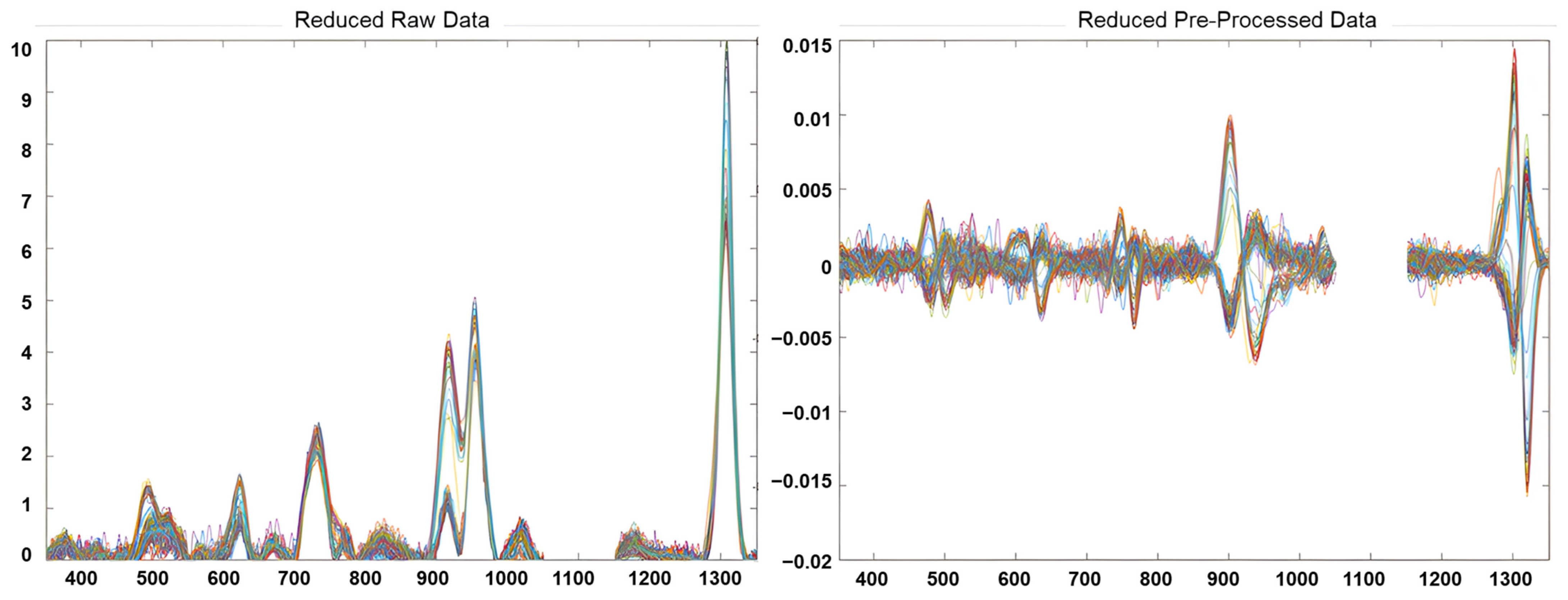

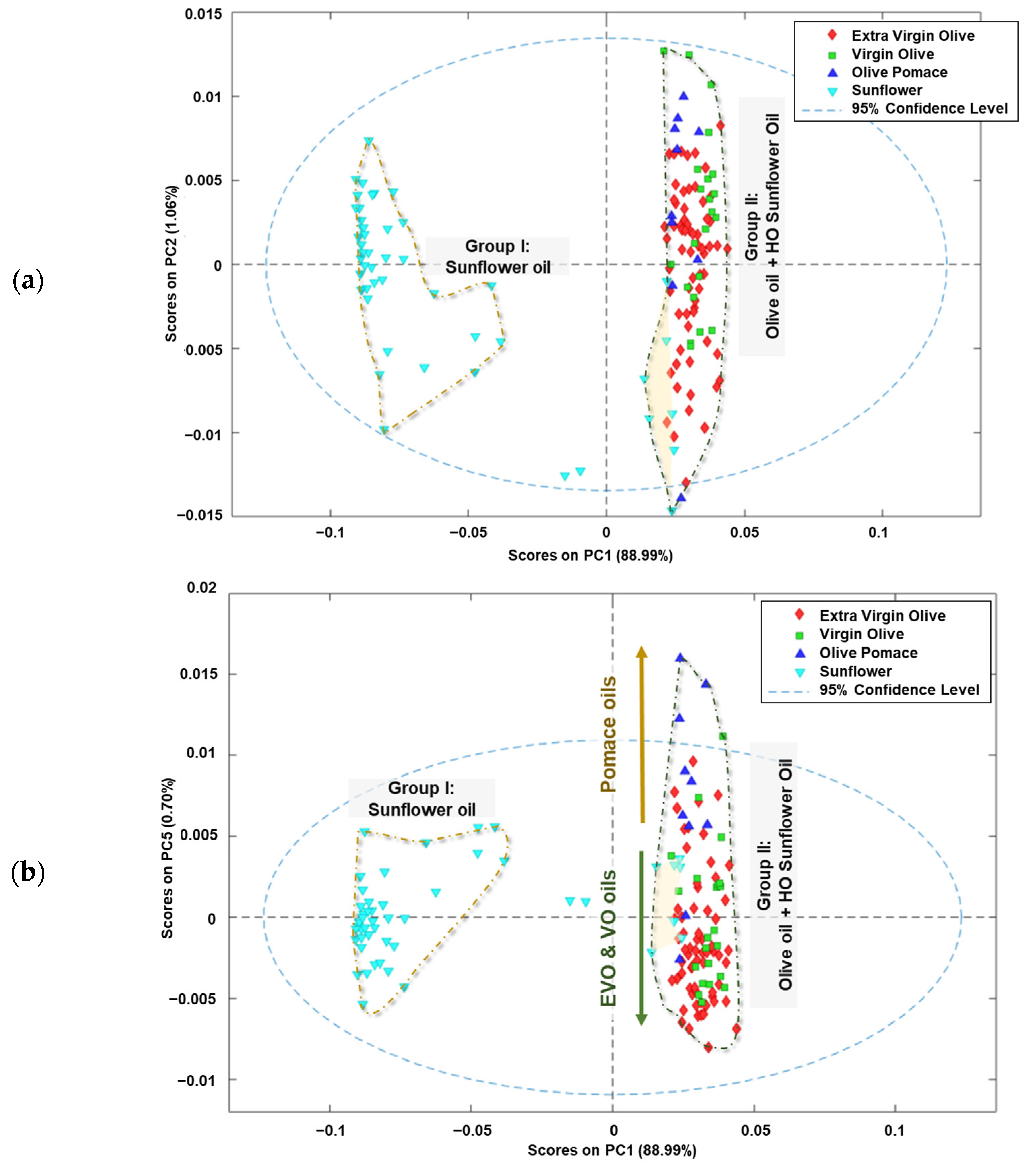
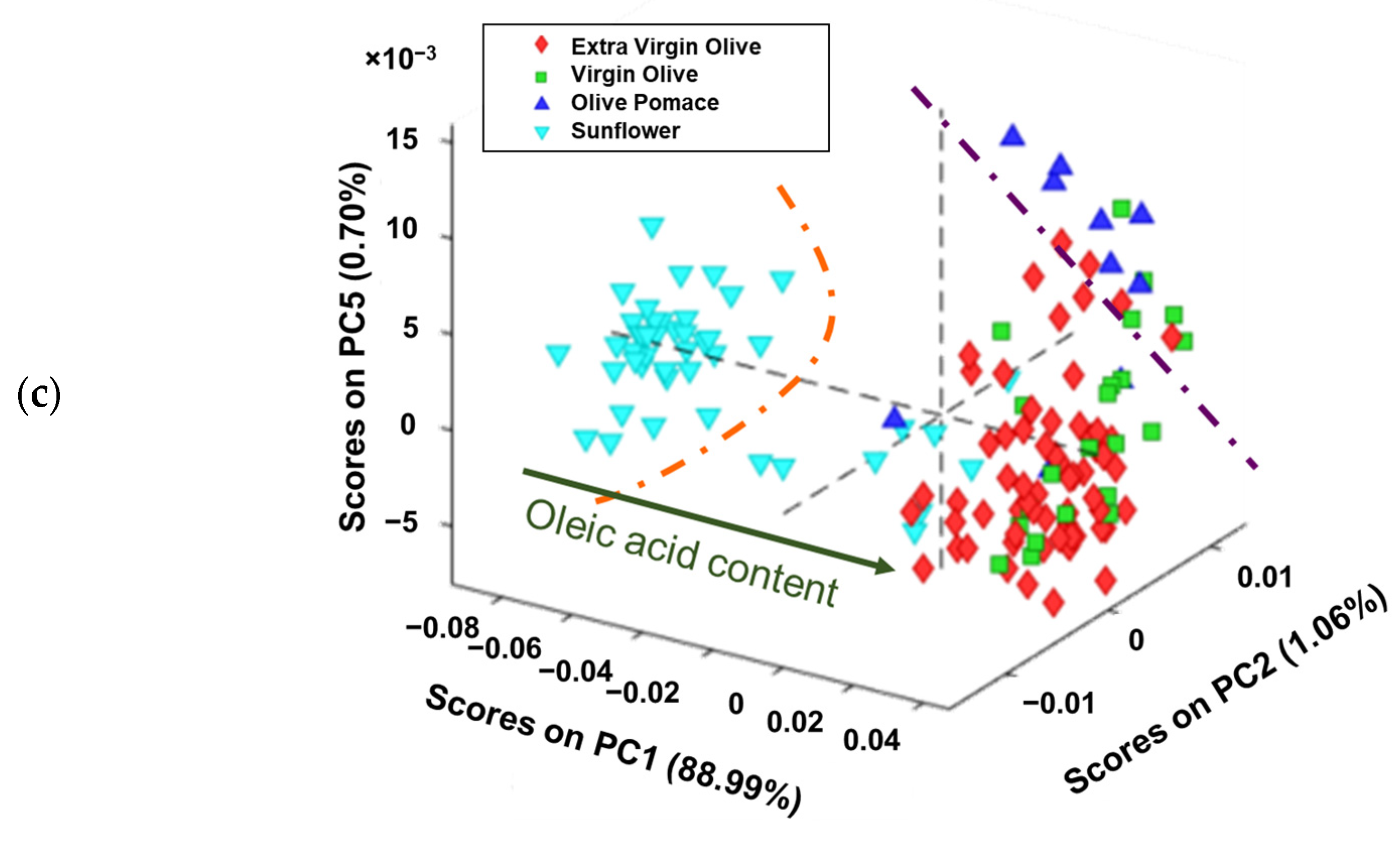
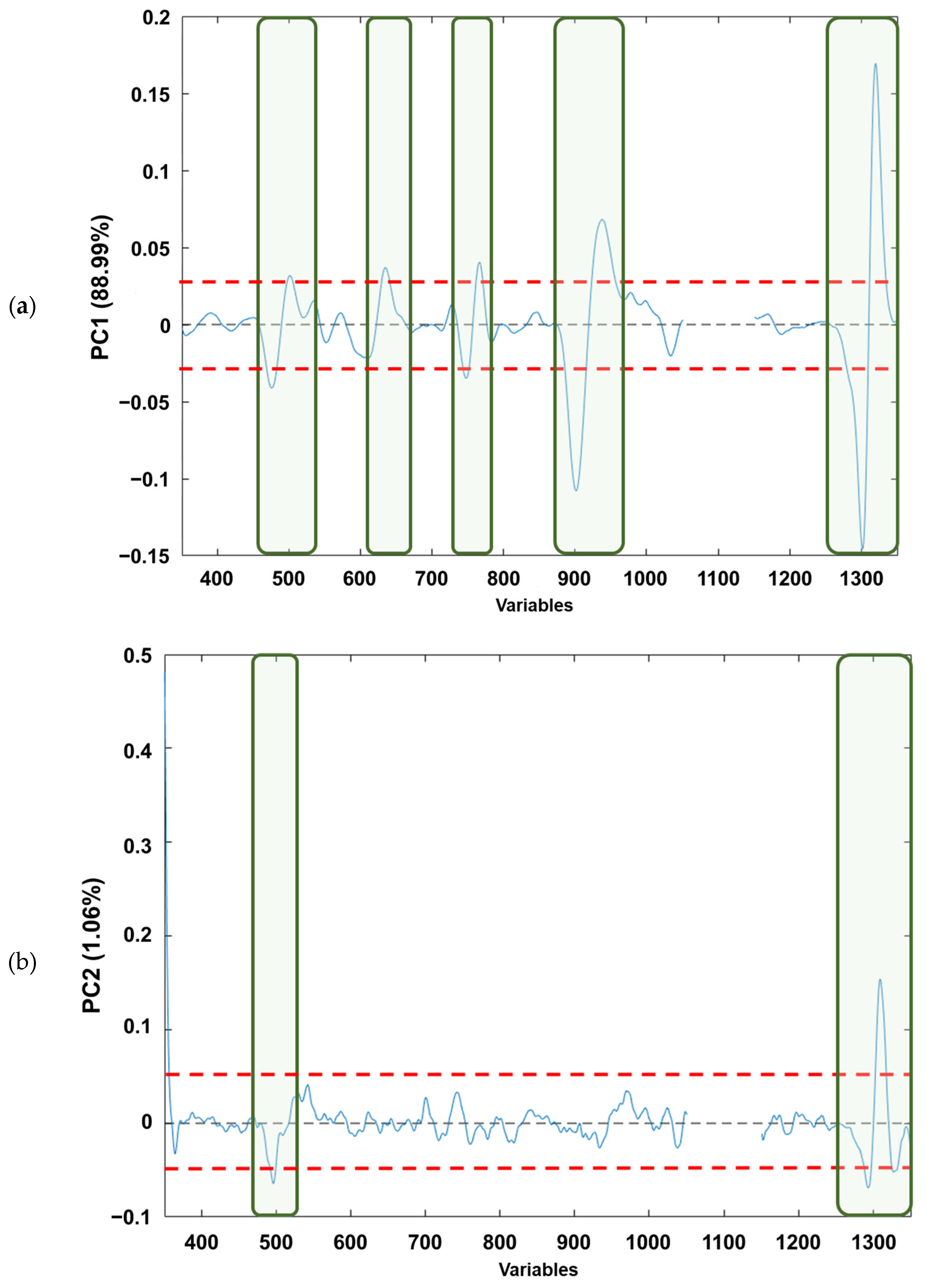

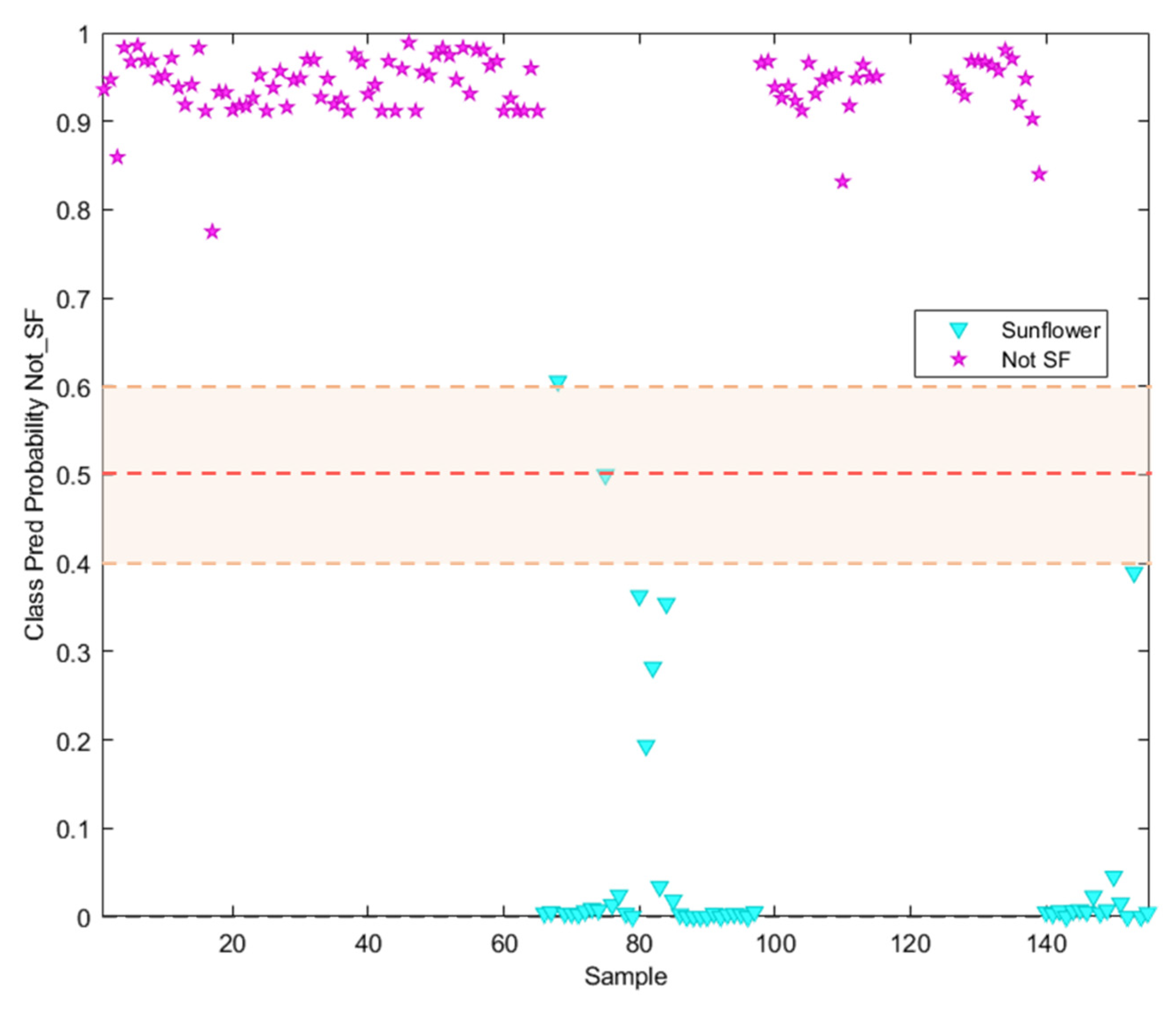

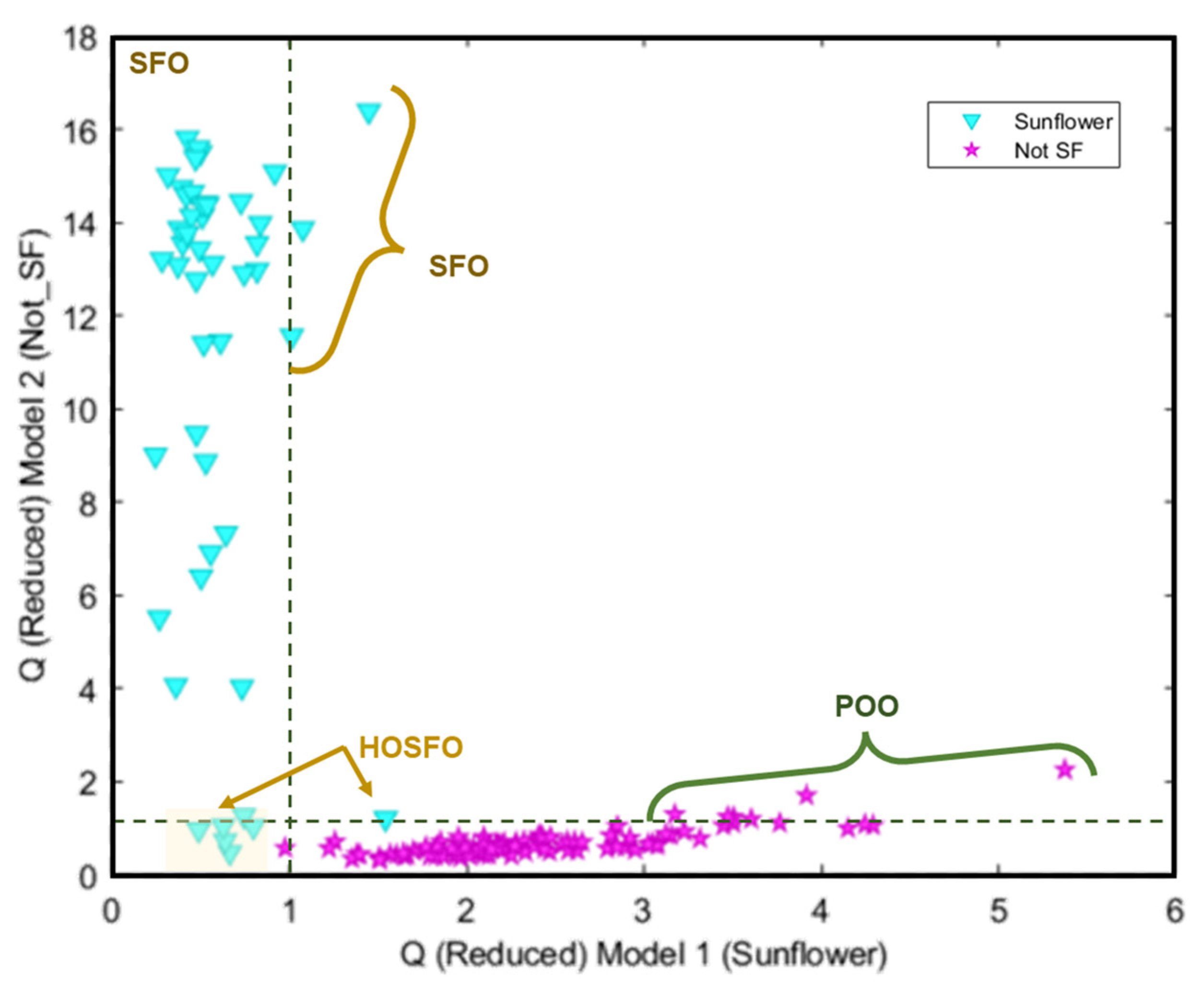
| TARGET Class (TC): Sunflower Oil | ||
|---|---|---|
| Features: X Block: [reduced RAMAN instrumental fingerprints] Y Block: [TC (sunflower oil, SFO); NTC (not sunflower oil, not SFO)] Preprocessing: 1st Derivative (order 2, window; 21 pt, tails: polyinterp) + Mean center Training Set: [97 × 902] Prediction Set: [48 × 902] See Confusion Table below | ||
| Classification performance metrics | TC (SFO) | NTC (Not SFO) |
| Sensitivity (SENS -prediction stage) | 0.98 | 1.00 |
| Specificity (SPEC-prediction stage) | 1.00 | 0.98 |
| False positive rate (FPR) | 0.00 | 0.02 |
| False negative rate (FNR) | 0.02 | 0.00 |
| Positive predictive value (precision) (PPV) | 1.00 | 0.99 |
| Negative predictive value (NPV) | 0.99 | 1.00 |
| Youden index (YOUD) | 0.98 | 0.98 |
| F-measure (F) | 0.99 | 0.99 |
| Discriminant power (DP) | - | - |
| Efficiency (or accuracy) (EFFIC) | 0.99 | 0.99 |
| Misclassification rate (MR) | 0.01 | 0.01 |
| AUC (correctly classified rate) | 0.99 | 0.99 |
| Gini coefficient (Gini) | 0.98 | 0.98 |
| G-mean (GM) | 0.99 | 0.99 |
| Matthews correlation coefficient (MCC) | 0.98 | 0.98 |
| Chance agreement rate (CAR) | 0.56 | 0.56 |
| Chance error rate (CER) | 0.44 | 0.44 |
| Kappa coefficient (KAPPA) | 0.98 | 0.98 |
| Confusion Table: | ||
 | ||
| TARGET Class (TC): Sunflower Oil | ||
|---|---|---|
| Features: X Block: [reduced RAMAN instrumental fingerprints] Y Block: [TC (sunflower oil, SFO); NTC (not sunflower oil, not SFO)] Preprocessing: 1st Derivative (order 2, window; 21 pt, tails: polyinterp) + Mean center Training Set: [97 × 902] Prediction Set: [48 × 902] See Confusion Table below | ||
| Classification performance metrics | TC (SFO) | NTC (Not SFO) |
| Sensitivity (SENS-prediction stage) | 0.90 | 1.00 |
| Specificity (SPEC-prediction stage) | 1.00 | 0.90 |
| False positive rate (FPR) | 0.00 | 0.10 |
| False negative rate (FNR) | 0.10 | 0.00 |
| Positive predictive value (precision) (PPV) | 1.00 | 0.95 |
| Negative predictive value (NPV) | 0.95 | 1.00 |
| Youden index (YOUD) | 0.90 | 0.90 |
| F-measure (F) | 0.95 | 0.97 |
| Discriminant power (DP) | - | - |
| Efficiency (or accuracy) (EFFIC) | 0.97 | 0.97 |
| Misclassification rate (MR) | 0.03 | 0.03 |
| AUC (correctly classified rate) | 0.95 | 0.95 |
| Gini coefficient (Gini) | 0.90 | 0.90 |
| G-mean (GM) | 0.95 | 0.95 |
| Matthews correlation coefficient (MCC) | 0.92 | 0.92 |
| Chance agreement rate (CAR) | 0.57 | 0.57 |
| Chance error rate (CER) | 0.44 | 0.44 |
| Kappa coefficient (KAPPA) | 0.92 | 0.92 |
| Confusion Table: | ||
 | ||
| TARGET Class (TC): Sunflower Oil | ||
|---|---|---|
| Features: X Block: [reduced RAMAN instrumental fingerprints] Y Block: [TC (sunflower oil, SFO); NTC (not sunflower oil, not SFO)] Preprocessing: 1st Derivative (order 2, window; 21 pt, tails: polyinterp) + Mean center Training Set: [97 × 902] Prediction Set: [48 × 902] See Confusion Table below | ||
| Classification performance metrics | TC (SFO) | NTC (Not SFO) |
| Sensitivity (SENS -prediction stage) | 0.93 | 0.81 |
| Specificity (SPEC-prediction stage) | 0.81 | 0.93 |
| False positive rate (FPR) | 0.19 | 0.07 |
| False negative rate (FNR) | 0.07 | 0.19 |
| Positive predictive value (precision) (PPV) | 0.99 | 1.00 |
| Negative predictive value (NPV) | 1.00 | 0.99 |
| Youden index (YOUD) | 0.74 | 0.74 |
| F-measure (F) | 0.96 | 0.90 |
| Discriminant power (DP) | 0.96 | 0.96 |
| Efficiency (or accuracy) (EFFIC) | 0.89 | 0.89 |
| Misclassification rate (MR) | 0.11 | 0.11 |
| AUC (correctly classified rate) | 0.87 | 0.87 |
| Gini coefficient (Gini) | 0.74 | 0.74 |
| G-mean (GM) | 0.87 | 0.87 |
| Matthews correlation coefficient (MCC) | 0.86 | 0.86 |
| Chance agreement rate (CAR) | 0.51 | 0.51 |
| Chance error rate (CER) | 0.44 | 0.44 |
| Kappa coefficient (KAPPA) | 0.78 | 0.78 |
| Confusion Table: | ||
 | ||
Disclaimer/Publisher’s Note: The statements, opinions and data contained in all publications are solely those of the individual author(s) and contributor(s) and not of MDPI and/or the editor(s). MDPI and/or the editor(s) disclaim responsibility for any injury to people or property resulting from any ideas, methods, instructions or products referred to in the content. |
© 2024 by the authors. Licensee MDPI, Basel, Switzerland. This article is an open access article distributed under the terms and conditions of the Creative Commons Attribution (CC BY) license (https://creativecommons.org/licenses/by/4.0/).
Share and Cite
Jiménez-Hernández, G.; Ortega-Gavilán, F.; Bagur-González, M.G.; González-Casado, A. Discrimination/Classification of Edible Vegetable Oils from Raman Spatially Solved Fingerprints Obtained on Portable Instrumentation. Foods 2024, 13, 183. https://doi.org/10.3390/foods13020183
Jiménez-Hernández G, Ortega-Gavilán F, Bagur-González MG, González-Casado A. Discrimination/Classification of Edible Vegetable Oils from Raman Spatially Solved Fingerprints Obtained on Portable Instrumentation. Foods. 2024; 13(2):183. https://doi.org/10.3390/foods13020183
Chicago/Turabian StyleJiménez-Hernández, Guillermo, Fidel Ortega-Gavilán, M. Gracia Bagur-González, and Antonio González-Casado. 2024. "Discrimination/Classification of Edible Vegetable Oils from Raman Spatially Solved Fingerprints Obtained on Portable Instrumentation" Foods 13, no. 2: 183. https://doi.org/10.3390/foods13020183
APA StyleJiménez-Hernández, G., Ortega-Gavilán, F., Bagur-González, M. G., & González-Casado, A. (2024). Discrimination/Classification of Edible Vegetable Oils from Raman Spatially Solved Fingerprints Obtained on Portable Instrumentation. Foods, 13(2), 183. https://doi.org/10.3390/foods13020183








